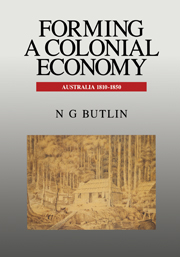Book contents
- Frontmatter
- Contents
- List of Tables
- List of Figures
- Acknowledgements
- Part I Forming an Economy
- Part II The Colonial Peopling of Australia: 1788–1850
- 1 Introduction
- 2 Gross Additions to the Australian Population
- 3 The Colonial Population Stock
- 4 Human Capital in Convicts
- Part III Public Funding of Colonial Development: 1788–1850
- Part IV The Colonial Australian Economy 1810–1840—A Historical, Statistical and Analytical Account
- Bibliography
- Appendixes
- Index
2 - Gross Additions to the Australian Population
from Part II - The Colonial Peopling of Australia: 1788–1850
Published online by Cambridge University Press: 04 August 2010
- Frontmatter
- Contents
- List of Tables
- List of Figures
- Acknowledgements
- Part I Forming an Economy
- Part II The Colonial Peopling of Australia: 1788–1850
- 1 Introduction
- 2 Gross Additions to the Australian Population
- 3 The Colonial Population Stock
- 4 Human Capital in Convicts
- Part III Public Funding of Colonial Development: 1788–1850
- Part IV The Colonial Australian Economy 1810–1840—A Historical, Statistical and Analytical Account
- Bibliography
- Appendixes
- Index
Summary
The Determinants of Convict Inflow to Australia
Even though, as suggested previously, there may have been other imperial motives behind the British settlement of Australia, there is no doubt that the transportation of convicts to the Antipodes was a convenient solution to social, judicial and budgetary problems in Britain in the 1780s. Britain had, at the time of the American Revolution, been accustomed to shipping out to the plantations an annual average of the order of 1000 transported convicts. The Revolution cut off that outlet (the West Indies and Africa remained available). Australian settlement did not offer the cheap American solution of disposing of convicts to private masters. The more expensive arrangement of passing transportees into the hands of the colonial governor for disposal had, of necessity in the first instance, to be adopted. But for a distant imperial venture, with no prospect of indigenous labour to engage, the use of unfree convict labour under public discipline and direction may have appeared to have considerable merit. A possible counterfactual, the free occupation of Australia by individuals from the beginning, seems beyond the bounds of plausible consideration. There is, then, no necessary conflict between imperial and penal motives in the colonial settlement of Australia.
Nevertheless, the expense of such a convict–imperial undertaking was and remained an important consideration and, indeed, after a mere three decades of settlement it was possible to adopt a general policy akin, though not identical, to the old American-style solution of convict assigment to private employers.
- Type
- Chapter
- Information
- Forming a Colonial EconomyAustralia 1810–1850, pp. 10 - 31Publisher: Cambridge University PressPrint publication year: 1994

